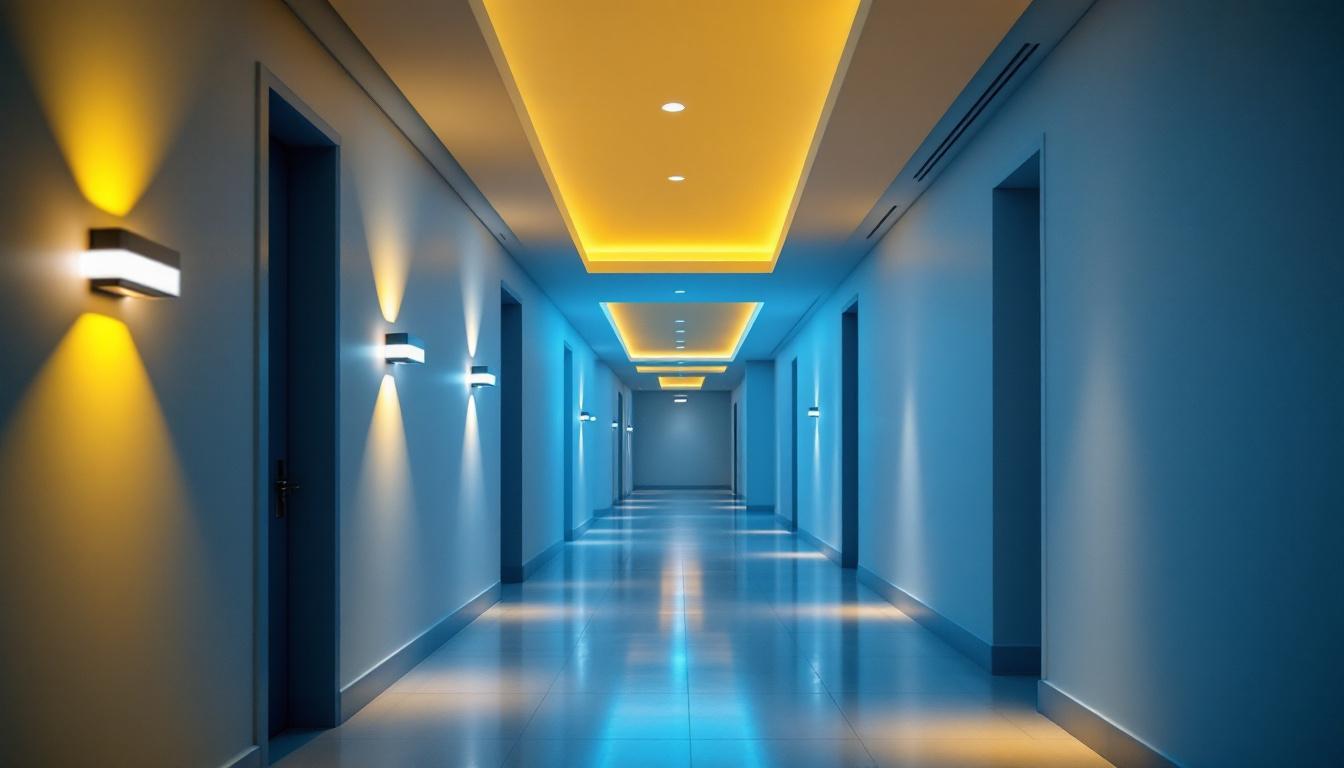
In the ever-evolving world of lighting technology, motion light LEDs have emerged as a significant trend that lighting contractors must stay informed about. These innovative lighting solutions not only enhance security but also contribute to energy efficiency and user convenience. As the demand for smart, sustainable, and versatile lighting solutions grows, understanding the latest trends in motion light LEDs becomes essential for contractors looking to stay ahead in the industry.
Motion light LEDs are designed to automatically turn on when they detect movement within a specified range. This functionality makes them ideal for various applications, including outdoor security lighting, indoor motion-sensitive lighting, and even decorative lighting. The technology behind these lights has advanced considerably, resulting in more efficient, reliable, and user-friendly options. With the integration of smart technology, many motion light LEDs can now be controlled remotely via smartphone apps, allowing users to customize settings such as sensitivity, duration, and even the brightness of the light. This level of control not only enhances convenience but also allows for greater energy savings.
The core of motion light LEDs lies in their sensors, which can be passive infrared (PIR), microwave, or dual technology. PIR sensors detect heat emitted by moving objects, making them suitable for outdoor environments. Microwave sensors, on the other hand, emit microwave pulses and measure the reflection to detect movement, making them effective in larger areas. Dual technology combines both methods for increased reliability. These sensors can be finely tuned to ignore small animals or other non-threatening movements, ensuring that the lights only activate when necessary, thus preventing unnecessary energy usage and wear on the bulbs.
Understanding the operational principles of these sensors allows contractors to select the right type of motion light for specific applications, ensuring optimal performance and user satisfaction. For instance, in a residential setting, a PIR sensor might be perfect for a porch light, while a microwave sensor could be better suited for a large warehouse where movement is more frequent and varied. The choice of sensor can significantly impact the effectiveness and efficiency of the lighting solution.
One of the most compelling advantages of motion light LEDs is their energy efficiency. Traditional lighting systems often remain on for extended periods, wasting energy and increasing costs. In contrast, motion light LEDs only activate when needed, significantly reducing energy consumption. This feature aligns with the growing emphasis on sustainability in the construction and renovation sectors. By utilizing motion light LEDs, property owners can not only save on electricity bills but also contribute to a more sustainable future by reducing their overall energy demand.
Contractors can leverage this trend by promoting motion light LEDs as a way to meet energy efficiency standards and reduce carbon footprints. Additionally, many motion light LEDs are designed to be compatible with solar power, further enhancing their eco-friendly appeal. This compatibility allows for installation in remote locations where traditional electrical wiring may be impractical or too costly. Furthermore, the longevity of LED technology means that these lights can last for years without needing replacement, further reducing waste and the environmental impact associated with frequent bulb changes. As consumers become increasingly environmentally conscious, the demand for such innovative lighting solutions continues to rise, making motion light LEDs a smart choice for modern construction projects.
As technology continues to advance, several trends are shaping the future of motion light LEDs. Staying informed about these trends will enable lighting contractors to offer cutting-edge solutions to their clients.
The integration of smart technology into motion light LEDs is one of the most significant trends in the industry. Many modern motion lights can now connect to smart home systems, allowing users to control their lighting remotely through smartphone apps or voice commands. This feature not only enhances convenience but also allows for greater customization of lighting settings.
Contractors should consider recommending smart motion light solutions to clients who prioritize technology and convenience. The ability to adjust lighting schedules, sensitivity, and brightness levels remotely can significantly enhance user experience and satisfaction.
Recent advancements have led to improved detection capabilities in motion light LEDs. Newer models can now detect movement at greater distances and through various obstacles, such as foliage or furniture. This enhancement ensures that lights activate only when necessary, providing greater security and efficiency.
Contractors should stay updated on the latest models and their specifications to advise clients effectively on the best options for their unique environments. Enhanced detection capabilities can be a strong selling point for residential and commercial applications alike.
As motion light LEDs become more popular, design and aesthetics have also evolved. Manufacturers are now offering a wider range of styles, colors, and finishes to suit different architectural designs and personal preferences. From sleek and modern fixtures to more traditional designs, there is a motion light LED to fit every aesthetic.
Lighting contractors should be aware of these design trends to help clients choose fixtures that not only serve functional purposes but also enhance the overall appearance of their spaces. A well-designed motion light can complement a home or business’s aesthetic while providing practical benefits.
The versatility of motion light LEDs allows them to be used in various applications, making them an attractive option for contractors. Understanding these applications can help contractors better serve their clients and meet their specific needs.
In residential settings, motion light LEDs are commonly used for outdoor security lighting, illuminating pathways, driveways, and entryways. They provide homeowners with peace of mind by deterring potential intruders and enhancing safety during nighttime hours.
Additionally, motion light LEDs can be installed in garages, basements, and attics, where they automatically illuminate when someone enters the space. This feature is particularly useful for families with children or elderly members, as it reduces the risk of accidents in dark areas.
For commercial properties, motion light LEDs offer significant advantages in terms of security and energy savings. They can be installed in parking lots, loading docks, and building entrances, ensuring that these areas are well-lit when needed while minimizing energy costs during off-peak hours.
Moreover, businesses can benefit from motion light LEDs in interior spaces, such as restrooms, hallways, and storage areas. By using motion sensors, these lights can reduce energy consumption and maintenance costs, making them an attractive option for businesses looking to improve their bottom line.
Public spaces, such as parks, schools, and hospitals, can also benefit from motion light LEDs. In parks, these lights can enhance safety for visitors during evening hours while conserving energy when the park is not in use. Schools can use motion light LEDs in hallways and classrooms to ensure safety and energy efficiency.
Hospitals can implement motion light systems in patient rooms and corridors, providing essential lighting when needed while reducing energy waste. The adaptability of motion light LEDs makes them suitable for a wide range of public and institutional applications.
While motion light LEDs offer numerous benefits, contractors should also be aware of potential challenges and considerations when recommending and installing these systems.
Installing motion light LEDs can be more complex than traditional lighting systems, particularly when integrating smart technology. Contractors must ensure that the sensors are positioned correctly to avoid false triggers or missed detections. Additionally, wiring and connectivity for smart systems may require specialized knowledge and skills.
Contractors should be prepared to invest time in training and staying updated on the latest installation techniques and technologies to provide the best service to their clients.
Educating clients about the benefits and functionalities of motion light LEDs is crucial for successful installations. Many clients may be unfamiliar with the technology and its advantages, leading to misconceptions or hesitations about investing in these systems.
Contractors should take the time to explain how motion light LEDs work, their energy-saving capabilities, and the various applications they can be used for. Providing demonstrations or case studies can also help clients understand the value of these systems.
While motion light LEDs can offer long-term savings through reduced energy consumption, the initial investment may be higher than traditional lighting options. Contractors should be prepared to discuss the return on investment (ROI) with clients, highlighting the potential savings over time.
Offering financing options or highlighting available rebates for energy-efficient installations can also help alleviate concerns about upfront costs. By addressing these financial considerations, contractors can build trust and confidence with their clients.
The future of motion light LEDs looks promising, with continued advancements in technology and design. As more consumers and businesses prioritize energy efficiency and smart technology, the demand for motion light LEDs is expected to grow.
Future innovations may include even more advanced sensors that can differentiate between types of movement, allowing for more tailored lighting responses. Additionally, developments in solar-powered motion light LEDs could further enhance their appeal, particularly in areas with limited access to electrical infrastructure.
Contractors should keep an eye on these emerging technologies to stay competitive and offer the latest solutions to their clients.
As awareness of the benefits of motion light LEDs increases, contractors can expect to see expanding market opportunities. Residential clients are becoming more interested in smart home technologies, while commercial and public sector clients are seeking energy-efficient solutions to reduce operational costs.
By positioning themselves as knowledgeable experts in motion light LED technology, contractors can tap into these growing markets and establish themselves as leaders in the field.
Motion light LEDs represent a significant trend in the lighting industry, offering numerous benefits in terms of energy efficiency, convenience, and security. As technology continues to evolve, lighting contractors must stay informed about the latest trends and innovations to provide the best solutions for their clients.
By understanding the applications, challenges, and future outlook for motion light LEDs, contractors can position themselves as trusted advisors in the field. Embracing these trends will not only enhance their service offerings but also contribute to a more sustainable and efficient future in lighting.
Ready to elevate your lighting game with the latest motion light LED technology? Look no further than LumenWholesale, where we provide lighting contractors with superior, spec-grade lighting products at unbeatable wholesale prices. Our commitment to quality, affordability, and convenience ensures that you have access to the best lighting solutions for your clients, without the hassle of inflated markups or hidden fees. Plus, with free shipping on bulk orders, you can stock up on high-performance lighting and pass the savings on to your clients. Don’t miss out on the opportunity to enhance your service offerings with our extensive selection of reliable lighting products. Wholesale Lighting at the Best Value is just a click away—visit LumenWholesale today and make your next project shine.

Explore the pros and cons of hallway recessed lighting compared to alternative options.

Discover how LED grow lights are revolutionizing lighting contractors’ projects by enhancing energy efficiency, improving plant growth, and offering innovative design possibilities.

Discover why staying informed about the latest in 3500 lumens technology is crucial for lighting contractors.

Discover the transformative power of outdoor solar lighting and why it’s essential for lighting contractors to stay ahead.